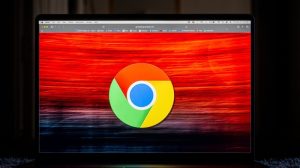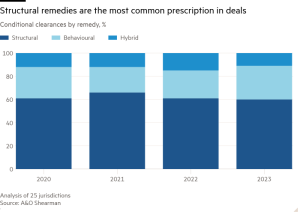How Arm could be the unexpected winner of the AI investment boom
Almost 20 years ago, Intel made a decision that changed the course of computing history.
Soon after Apple started putting Intel inside its Mac computers in 2005, Steve Jobs pitched the chipmaker’s then chief executive, Paul Otellini, on its top-secret plan to break into the mobile phone business. Intel turned down Jobs — and what would become the iPhone.
One result of Intel’s decision was to hand UK-based tech group Arm an effective monopoly on the chip designs that now power virtually every mobile phone, a $500bn market that is more than twice the size of the PC industry.
Thanks to its uniquely energy efficient technology, Arm is now using that same platform to outpace Intel again in the era of artificial intelligence, as Big Tech companies spend billions of dollars to build massive new power-guzzling data centres.
Arm has been a huge beneficiary of the investor fervour for semiconductor companies that has also propelled Nvidia’s valuation to more than $3tn. Shares in Arm have nearly tripled since the SoftBank-backed company went public last year and it is now valued at around $157bn. After its annual revenues grew 21 per cent to $3.2bn in the fiscal year to March, Arm’s market capitalisation overtook Intel, once a Silicon Valley icon, this summer.
If those valuations look frothy to some AI sceptics, Arm chief executive Rene Haas is convinced the AI boom is only just getting started. He told a Bloomberg conference in London last week that betting against an AI future would be like saying “the internet’s not going to happen” when the dotcom bubble burst in 2000 or “the automobile’s not going to happen” after the stock market panic of 1907.
“We’ve seen such advancement across AI in the last couple of years that the amount of innovation this is going to drive is just going to be incredible,” Haas said. More powerful processors will be needed to create better AI models, he added. “I’m pretty optimistic about the growth for our industry.”
At the moment, Arm’s role in the AI spending spree is principally as an ally to Nvidia. Arm-based central processing units (CPUs) are being installed alongside Nvidia’s new Blackwell series of AI processors in the vast data centres that Microsoft and OpenAI are building to train the next generation of ChatGPT, for instance.
But if Masayoshi Son, SoftBank chief executive, gets his way, Arm could soon end up in direct competition with Nvidia, by building its own AI chips.
FT Edit
This article was featured in FT Edit, a daily selection of eight stories to inform, inspire and delight, free to read for 30 days. Explore FT Edit here ➼
Following the initial public offering, SoftBank still owns about 90 per cent of Arm, and Son would like the company to grab a much bigger share of the economic value of chips than it currently receives from just designs.
After SoftBank took a $500mn stake in OpenAI earlier this month, Son wants to put Arm technology at the centre of a new network of data centres, purpose-built to train and run AI systems, according to people familiar with his thinking. That would not only put Arm on a collision course with Nvidia but also mark a dramatic departure from its traditional business model of selling only intellectual property.
That prospect alarms some of Arm’s old guard, who fear it could destabilise its role as the chip industry’s neutral “Switzerland”, selling its designs to everyone and rarely competing with its licensees. Son’s latest scheme, when coupled with a rapidly escalating legal battle with another big customer, smartphone chipmaker Qualcomm, has raised fears that Arm is struggling to maintain good relations with its partners while also trying to move up the semiconductor food chain.

Replicating Nvidia’s formidable computing horsepower, and its long established community of AI developers, poses an immense challenge. “When you think about the investment needed to go out and really compete against Nvidia, it really makes your eyes bleed,” says a former Arm executive.
Despite the risks, SoftBank is determined to play a central role in what Son believes is the next stage of human evolution, according to people familiar with his thinking.
“Many people still doubt . . . [but] I think Nvidia is undervalued,” Son told the Future Investment Initiative conference on Tuesday in Riyadh. “Because the future is much bigger.”
Haas has not commented on the specifics of SoftBank’s scheme, but told the Bloomberg event last week: “All those AI workloads are going to run on Arm somewhere, somehow. That’s the reason we spend a lot of time talking to SoftBank about the future.”
Since Arm started out in a barn in Cambridgeshire in the early 1990s, its designs have shipped in almost 300bn devices. It makes less than a dollar from most of those chips: unlike Intel and Nvidia, Arm does not currently make its own processors.
Instead it licences its designs to anyone who wants to make their own chips, giving it a unique position in the tech industry. Arm provides the blueprints that chipmakers can use to build their processors.
For most of its 34-year existence, those customers have been overwhelmingly in the mobile phone business. Companies such as Apple, Samsung, Google and Qualcomm took advantage of the unparalleled energy efficiency of Arm’s designs. For battery-powered devices, Arm’s technology holds a key advantage over the x86 architecture used by Intel, which has dominated PCs and servers for decades.
As smartphones became most people’s primary computing devices, and as mobile chips became much more capable, Arm quietly built a powerful platform from which to attack Intel’s traditional strongholds in PCs and servers.
“Arm, when it came about, was really a disruptive innovation,” says Robert Burgelman, a professor at the Stanford Graduate School of Business. “It was not as good in performance in computing but it was better for non-PC devices because it was low power.”
Burgelman, who has studied Intel and the semiconductor industry for decades, says he initially underestimated Arm’s longer-term prospects. “What I didn’t realise was that the rate of increase in performance for Arm would be higher than the rate of decrease of power consumption for the Intel architecture. If you combine both, that’s a very dangerous situation [for Intel].”
Arm’s prospects in the personal computer market received a huge boost in 2020, when Apple released the first Macs based on its own M-series processors, ditching Intel at the same time. The M-series is based on the same Arm blueprints that Apple uses in its iPhones. The switch to its own chips brought much improved battery life to its laptops and other performance improvements as Apple was able to design its hardware and software in tandem. Earlier this year, Microsoft followed suit by putting Arm-based chips at the centre of its push to rejuvenate Windows with a new class of so-called AI PCs.
However, the Qualcomm-built chips that power the first wave of AI PCs have become the focus of a high-stakes legal fight. In 2021, Qualcomm acquired a start-up called Nuvia that had been developing PC chips based on Arm’s designs. Arm alleges that Qualcomm failed to obtain its permission to continue developing Nuvia’s chips, as required by the terms of its IP licence.
In an escalation that took many in the tech industry by surprise earlier this month, Arm issued an official notice that it would withdraw Qualcomm’s architecture licence altogether, preventing the San Diego-based chipmaker from shipping its latest generation of products, including a new range of mobile processors.
Wall Street took fright at what analysts called Arm’s “nuclear” move against one of its largest customers, sending its stock down 9 per cent in a day. Qualcomm has accused the chip designer of “strong-arm tactics” to boost its royalty rate. Arm insisted in a statement that it was “left with no choice” by Qualcomm’s “repeated material breaches of Arm’s licence agreement”.
The case, which is expected to go to trial in December, has exposed the complex relationships between Arm and its licensees at a time when it is expanding its customer base into new sectors.
The most promising of these new opportunities is in the huge data centres that cloud computing providers are building to fuel anticipated growth of services such as Google’s Gemini, OpenAI’s ChatGPT and Anthropic’s Claude.
Breakneck expansion of these vast server farms is already putting strain on the grid, boosting demand for Arm’s energy-efficient tech.

Goldman Sachs estimated earlier this year that data centres’ global power demands will grow 160 per cent by 2030. The bank’s analysts say data centres will use 8 per cent of US power by 2030, up from 3 per in 2022, while in Europe, these facilities will need as much energy as Portugal, Greece and the Netherlands combined by the end of this decade.
Getting into the data centre has been a long time coming for Arm. Amazon, the first cloud computing company to embrace Arm’s designs in its servers, first discussed the idea more than a decade ago.
James Hamilton, a senior vice-president and distinguished engineer at Amazon, pitched then-CEO Jeff Bezos on the idea of AWS creating its own data centre chips back in 2013. “If we want to continue to innovate on behalf of our customers . . . we’ve got to be in the semiconductor business,” Hamilton told Bezos and his successor, Andy Jassy, who was running AWS at the time.
But it was not until 2018 that AWS unveiled its first Arm-based CPU, Graviton, and initial sales were slow. Today, data centre chips still only make up just over 10 per cent of Arm’s royalty revenues, analysts say.
Nonetheless, Arm’s patience is finally paying off as Amazon’s cloud computing rivals all pile into the semiconductor business. After Microsoft launched Cobalt, its first Arm-based CPU for servers, a year ago, Google unveiled its own equivalent, Axion, in April.
But it is an alliance with Nvidia that is propelling Arm into the heart of the AI data centre. Nvidia’s latest GB200 “superchip” combines two of its Blackwell graphics processing units with an Arm-based Grace CPU. Nvidia’s $40bn attempt to buy Arm from SoftBank in 2020 failed amid antitrust scrutiny, but now the two companies have never been closer. An Nvidia-powered range of AI PCs, using an Arm CPU, is widely expected to launch next year.
Two types of processors

CPU
Workhorse processor: since the 1970s, this has been most computers’ core chip, found in smartphones, traditional PCs and servers
General purpose: runs the operating system and apps, handling a wide variety of tasks, one at a time
Main players: Intel, AMD in PCs; Arm-based chips made by Apple, Qualcomm, Samsung and MediaTek in mobile

GPU
Powerhouse processor: originally designed for video games, it is now key to a new breed of AI data centres
Specialised purpose: accelerates processing of a particular kind of computationally demanding task, by running them in parallel
Main players: Nvidia dominates, with AMD and Intel chasing. Microsoft, Google and Amazon also make bespoke AI accelerators
The two companies are so close that when Haas interviewed Nvidia chief Jensen Huang as the first guest on his new podcast recently, the pair joked about the thwarted deal, which had been vehemently opposed by many of Arm’s customers.
“You almost acquired us, which would have been fun,” says Haas, who is a former Nvidia executive. “I know you’re still sad about it,” replies Huang. “Every day I cry a little bit,” Haas laughs, “but I’m here.”
Despite the budding bromance, SoftBank’s Son wants to enlist Arm in his campaign to take on Nvidia, which currently dominates AI chip supply. Son is intent on investing billions of dollars to create a network of Arm-powered AI data centres, according to people familiar with his thinking.
Son’s ambition is to push Arm from an IP licensing business into a company that can produce the data centre chips necessary to both “train” or build AI models, and for “inference”, whereby the system responds to users’ queries. SoftBank’s purchase of UK AI chipmaker Graphcore in July was also driven by its expertise in bringing a chip into production, these people say.
As well as chip production and software, Son’s plans include providing power for the data centres. SoftBank is actively engaging with potential customers for its proposed system and has pitched Big Tech firms such as Google and Meta on the merits of creating a counterweight to Nvidia.
After earlier talks with Intel fell through, SoftBank is now in negotiations with Taiwan Semiconductor Manufacturing Company, the world’s largest contract chipmaker, to secure capacity in its foundry where the AI chips would be produced. However, people familiar with Son’s scheme caution that no public announcements are imminent. SoftBank declined to comment.
Speaking to the Financial Times last week, Haas admitted that replicating Nvidia’s entire technology “stack” — which includes not just chips but networking technology and software — would involve a “lot of heavy lifting”. Arm does make what it calls “neural processing units”, or NPUs, chips that are optimised for the neural networks needed for AI. But Haas conceded that Arm’s NPUs are “not in the performance level that Nvidia is at” because they are largely designed to run on so-called edge devices — smartphones, the “internet of things” and other products outside the cloud — rather than in data centres.
“But I can assure you that there is a lot of work under way in terms of how to broaden that space, beyond just the edge,” he said.
The irony is that SoftBank’s plan could have been much further along if Arm had not shelved one internal effort to develop standalone AI accelerator technology about five years ago, according to three former employees.
Arm was under pressure from SoftBank, which had acquired it for £24bn ($31bn) in 2016, to prepare for a return to the stock market. That meant focusing on proven, profitable businesses to make its margins shine for prospective investors. At the same time, some of Arm’s biggest customers, including Apple, Qualcomm and Graphcore, were raiding its engineering talent as they built up their own chip design capabilities.
Arm’s management team — including Haas, who at that time led its main product divisions — knew they needed to shore up its core CPU business. So Arm redeployed hundreds of engineers from a budding project building chips that were optimised for AI, sending them to work on its CPU instead. Although those engineers continued to build AI acceleration capabilities into Arm’s CPUs, the move meant that the company still lacks a standalone NPU product suitable for data centres today.
“We were bleeding processor engineers,” says a former Arm executive who was involved in the decision, “and in the end, the CPU is just more important.”

Analysts are sceptical that Arm, even with SoftBank’s resources behind it, can build a true competitor to Nvidia’s GPUs, whose success rests not only on its hardware expertise but also its widely used Cuda software, which would take years to replicate.
“I don’t see what tools they have to take on Nvidia,” says Edward Wilford, semiconductor analyst at Omdia, a tech consultancy.
“Arm doesn’t have [AI] accelerator IP for the data centre,” says Ben Bajarin of Creative Strategies, another consultancy. He believes that the most likely challengers to Nvidia’s dominance are Big Tech companies such as Microsoft, Google and Amazon, whose AI accelerator chips do not largely rely on Arm’s IP.
Publicly, Haas maintains that Arm does not need to compete with Nvidia to benefit from the AI boom. Chips based on Arm’s tech are already handling AI tasks such as photo editing on smartphones or image processing on security cameras. It recently collaborated with Meta to make a slimmed-down version of its Llama AI system that can run on its mobile CPUs.
“Seventy per cent of the world’s population touches Arm in some way,” Haas said at the Bloomberg event. “AI is going to run on Arm, period.”
But he rejects the idea that Arm has strayed too far from its humble British origins and got caught up in Silicon Valley’s AI hubris.
“We have an incredible opportunity to address an unprecedented market demand,” he told the FT. “If there’s anything changed inside of Arm, it’s a sense of urgency to take advantage of the opportunity.”
Additional reporting by Richard Waters, Michael Acton and Ahmed Al Omran
#Arm #unexpected #winner #investment #boom








